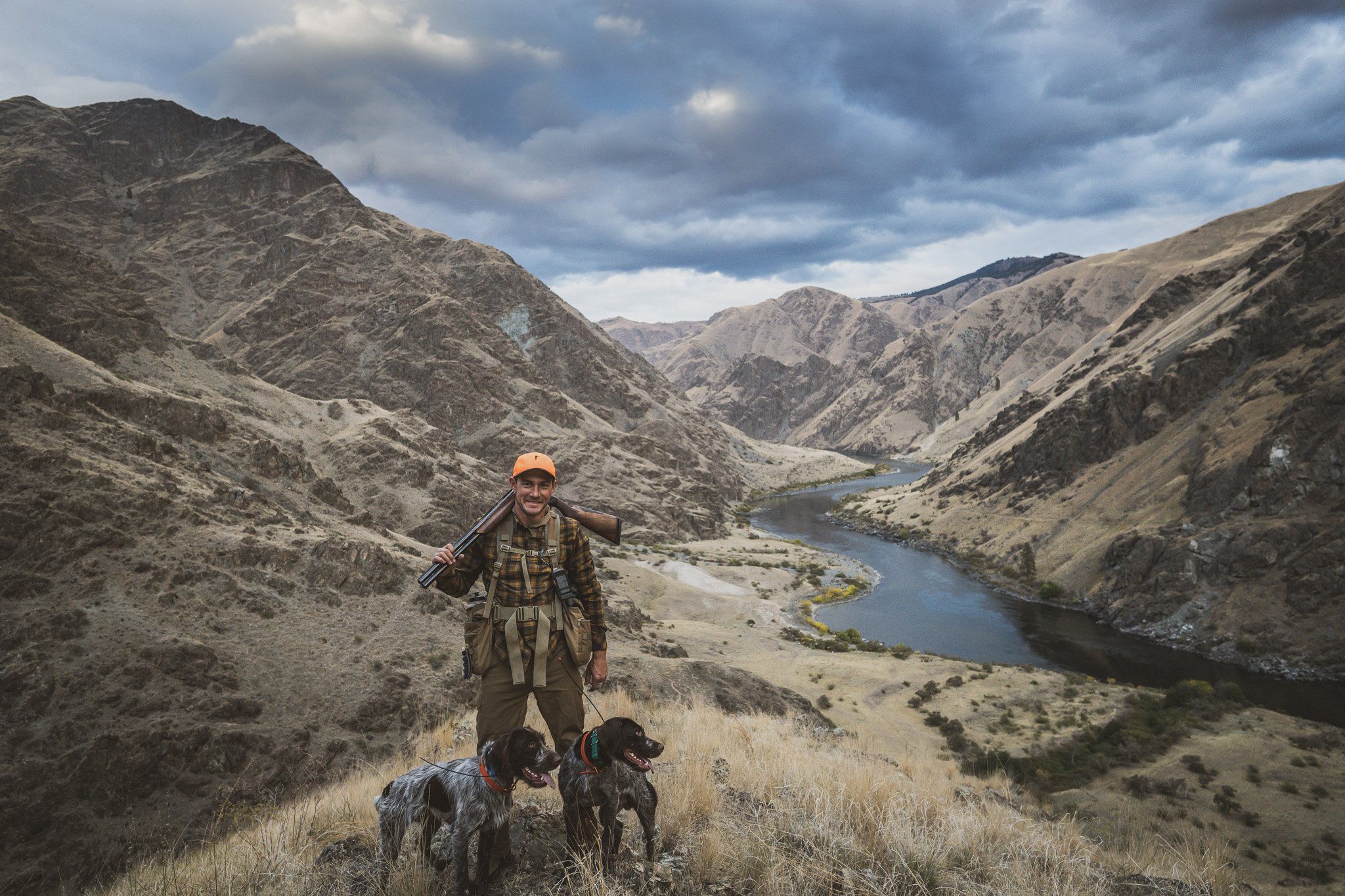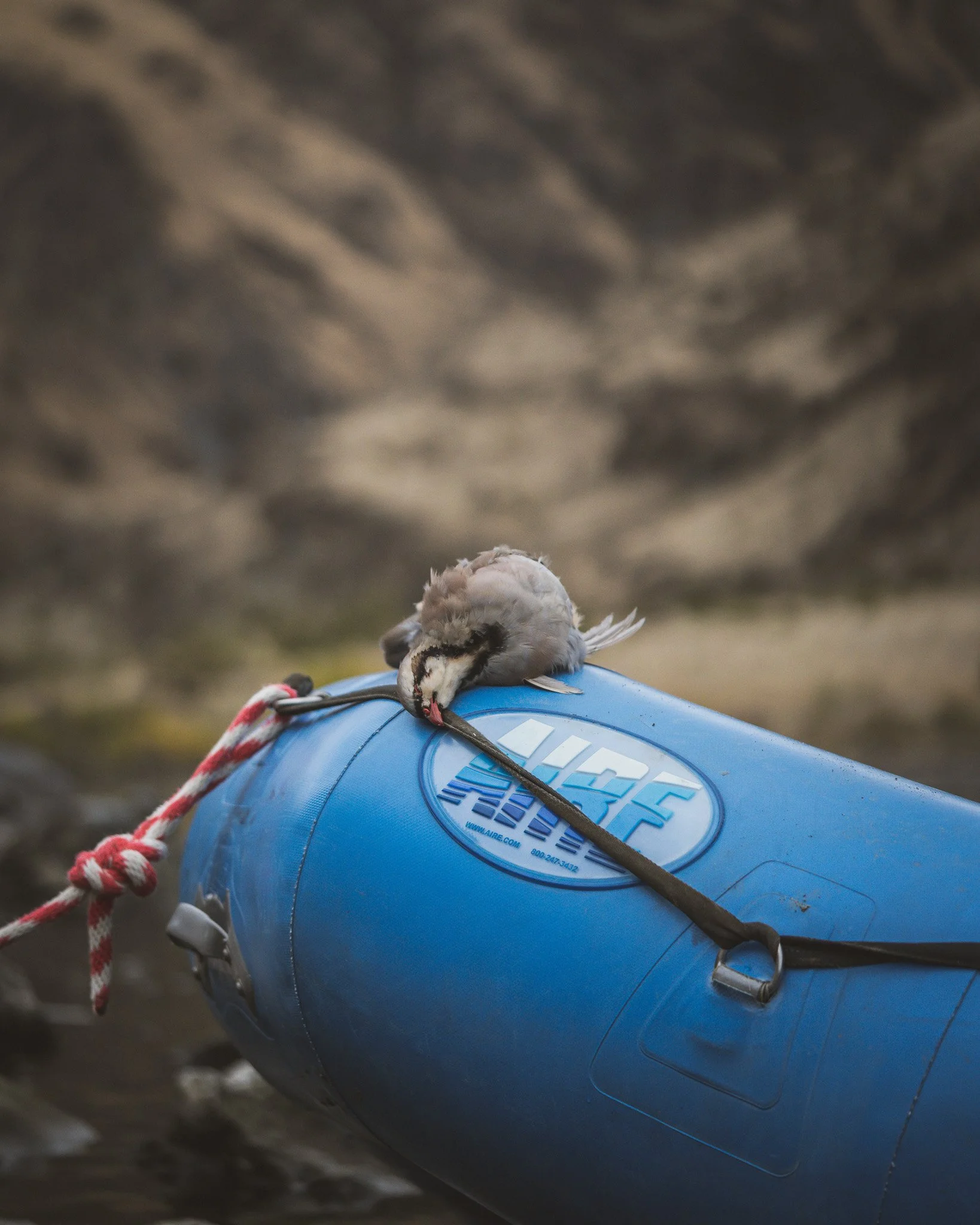Story: The devil you know is better than the devil you don’t.
A chukar hunting 101 of sorts.
My lungs ached as I gasped for breath. The lactic acid in my quads burned. The blood pumped so hard my temples throbbed. The steep climb to meet my dog on point seemed to last an eternity. As I approached my trusty hunting companion, I visualized the covey rise and the masked bandits dropping lifeless onto the cheatgrass below. In my head, the situation couldn’t be more perfect—the covey holding, my shotgun at the ready, my legs steady on the ground below me—but, as with all good daydreams, I was quickly brought back to reality by the explosion of wingbeats. The covey of red-legged devils burst out from beneath me, and as I raised my shotgun, my wobbling legs collapsed along with the rimrock I was standing on. Before I knew it, I was on my backside watching the birds touch down on the other side of the canyon. After all that exertion, all I had to show for myself was a new battle scar on the stock of my shotgun and a very disappointed bird dog giving me the side-eye.
If you’ve hunted chukar before, you’ve likely found yourself in a similar scenario more than once. The predictable unpredictability of the devil bird and the physical abuse is what keeps us coming back for more season after season until our knees can no longer take it. And finally, after hanging up our chukar boots for one last time, we’ll take those secret chukar spots with us to the grave. That is the journey of the chukar hunter.
How did we get here in the first place? After all our foe, Mr. Alectoris chukar himself isn’t even from these shores; he is an infidel from a distant land. He was brought here against his will and has made himself at home in the inhospitable mountain terrain of the West. He waits for moments like the one I described, and then he and his covey mates laugh at us from the mountain across the canyon.
The journey of the chukar on these shores can be traced back to 1893 when an Illinois man called W.O. Blaisdell imported five pairs of chukar from Karachi, India (Cottam et al., 1940). After the initial import of the birds, there were several attempts by states and provinces to introduce Alectoris chukar and similar subspecies throughout the subsequent years. From 1893 through around 1970, an estimated 800,000 chukar were introduced across the United States and Canada with the majority of those introductions being largely unsuccessful (Christensen, 1970). While the introductions were initially widespread and varied in success, the Great Basin region of California, Idaho, Nevada, Oregon, and Utah proved to offer the best habitat for chukar to thrive over multiple generations, so we find the best hunting opportunities today in that region. The beauty of this introduction was that the chukar did not take the place of any existing native species and in general overlaps only in part with California quail and the greater sage grouse.
Chukar are synonymous with the high desert landscape, residing on steep, rocky hillsides covered in short grasses and sage brush—very similar to its habitat in its native range of India, Pakistan, and Afghanistan. Their ability to travel long distances in search of suitable habitat and food has played a huge part in the expansion of their range, and while the Great Basin is their stronghold, there are also populations in other nearby Western states as well as British Columbia and six Hawaiian islands. In many places, they can also be found coexisting with another import, the Hungarian partridge, which creates the opportunity for an exciting mixed bag.
This description of habitat doesn’t help hunters much—it describes most of the Western United States—but as with any upland game bird, the focus for scouting new areas must be placed on locating food and water sources. The arid nature of the Great Basin means that water sources are scarce and are therefore frequented regularly and sometimes even fought over by desert wildlife. So whether it’s a spring, a creek, or a man-made guzzler, you know that it’s a great place to begin your search for chukar. If no water sources are close by, it’s safe to assume the chukar are getting their moisture from food.
Locating food sources is not so easy, however, as their diet is varied and dependent on the season and availability. They primarily feed on grasses and seeds, most notably an invasive species called cheatgrass (Bromus tectorum), a winter annual grass that seems to dominate much of the West these days and plays a huge part in the increase of fire in the sagebrush landscape. During the winter months and after heavy precipitation (a rarity in the Great Basin), hunters should look for green up, as birds will likely be close by to take advantage of this rarely available high nutrient food source. In times of drought, chukar have been known to dig and feed on bulbs and small onions found beneath the ground.
The contents of a chukar’s crop
While locating food and water is the logical strategy when seeking most upland game birds, the chukar’s presence can also be found from clues left on the hillside. They generally roost as a covey, and locating a roost is a surefire way to know that there are birds in that area. However, dating the roost is equally important, so don’t be shy about picking up a dropping and rubbing it between your fingers to check the moisture level. They will mostly roost among rocks but can also roost beneath sagebrush and juniper trees, so keep an eye out for these features on the landscape as you are walking around. Dusting bowls are another giveaway that you are on the right track. These round or oval depressions on the ground, often accompanied by feathers or droppings nearby, are where the birds have taken dust baths, a behavior that helps them maintain their plumage.
Chukar are naturally very vocal birds, so in the absence of food or water sources, they can sometimes be located simply by listening. Their famous chuk chuk chuk chukarrrr call can be heard in the mornings and evenings as they try to locate other birds on the hillside. In the mountainous terrain they live in, this dead giveaway is a dream for chukar hunters who can focus all that climbing in the right direction and conserve some energy. The saving grace is that once located, chukar generally hold tight, allowing ample opportunity for hunters to climb the mountain and get within range. Their flush is explosive and often accompanied by a squeal as they lock their wings and fly across the canyon or J-hook out of sight. It’s one of the greatest experiences you can have while hunting birds out West, and it’s a moment I live for as an upland hunter.
Chukar terrain is steep and unforgiving, and the country is expansive. It’s best suited to a big running pointing dog. Dogs should be well conditioned to perform well in this terrain, and their pads need to be tough to contend with the jagged rim rock that’s ever present in chukar habitat. A good chukar dog will glide up the mountainside as if gravity didn’t exist only to come to a screeching halt when the devil birds are located—a sight that’s a joy to watch and will get your heart racing even more than the climb itself.
I’ve often heard chukar hunting described as Type 2 fun—an activity that’s enjoyable only once it has ended. I disagree with this. I am a glutton for punishment and always search for the most athletic upland opportunities, so I think that chukar hunting is fun from start to finish. The burn in your legs, the pounding in your chest, the lack of water, the unforgiving weather, the nasty terrain, the precarious positions you find yourself in—it all adds up to an experience like no other in the uplands. It is a true upland adventure every time you drop the tailgate and cut the dogs loose. The pain and suffering you endure throughout the day is all justified when that bird hits the ground below.
Chukar hunting seems intimidating, and while it’s not easy, it is incredibly accessible. Chukar habitat can be found all across the West, and the vast expanses of public land mean that you rarely see another hunter. The places chukar hunting will take you are remote and beautiful, and every time you are standing on top of a mountain, you swear to yourself that you are the first human to experience the views you are enjoying.
I will be forever grateful for the public land opportunities we have out West and especially thankful to those who introduced the chukar to North America, because, as they say, the devil you know is better than the devil you don’t.






